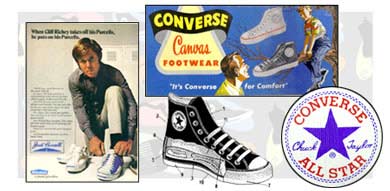Converse (Chuck Taylor All-Star)

Fashion Synopsis
Before there was the Pump or the Air, there was Converse. Before Michael Jordan put his name on Nike's Air Jordans, there was Chuck Taylor’s name scrawled across a circular ankle patch on Converse's All-Star high-top. Before high-tech performance wizardry, there was the no-bells-or-whistles canvas topper that guaranteed comfort, the Converse All-Star.
The Converse story began in 1908, when Marquis M. Converse created the Converse Rubber Company. By 1917, a rubber-soled, canvas sneaker, dubbed a high-top because of its ankle-high cut, became the forerunner of the legendary Converse All-Star. This high-top sneaker was competition for another shoe company producing athletic shoes: Keds. Early Keds were a strong competitor to the Converse All-Star, having a similar style and many of the same characteristics, right down to the circular ankle patch. But there was something Converse had that Keds didn’t: Chuck Taylor.
Charles ‘Chuck’ Taylor was a high school basketball all-star who never played without his All-Stars on his feet. After school, Chuck became a promotional salesman for Converse in 1921, helping to perfect the shoe for the perfect game. Chuck toured high school gyms, speaking with coaches and players, using their input to make the All-Star the best basketball shoe in the world.
Thanks in large part to Chuck, the shoe became extremely popular, and in 1923, Chuck Taylor’s signature was placed inside the circular patch on the ankle. Converse shoes are routinely referred to as “Chuck Taylors” or “Chucks” even to this day. And why the patch on the inside? Because the patch reportedly protects the anklebone, and prior to the technical wizardry of today’s performance shoes and super-reinforced ankle support, a little extra fabric was a big help.
The ultimate basketball shoe, Converse reigned king until the arrival of strong running shoe competitors, Nike and adidas. ‘Performance sneakers’ they were called, but Converse didn’t retreat to the benches. Converse saw renewed interest when both Dr. J and Larry Bird endorsed the shoe, but when Michael Jordan lent his image to the Air Jordan empire, it seemed as if All-Stars were lost. But the fanaticism behind the canvas high-top should never be underestimated.
The early All-Stars were either black or white, but an entire range of colors stepped up the pace in 1966, and by 1970, the suede One-Star became a big hit on and off the court. The 80’s resurrected the Converse All-Star when kids’ idol Punky Brewster made it her look to wear two-colored high-tops on her feet. The trend exploded (fluorescent blue with a fold-down fluorescent yellow top, and so on), and Converse was back on the map.
While Converse couldn’t compete with the high-performance athletic shoes, the traditional Converse All-Star remains a winner by sheer longevity, and popularity. By the end of the year 2000, more than 600,000,000 (yes, six hundred million) pairs of Converse had been sold in the less-than-100 years Converse has been around.
Converse has made other shoes throughout the years, from the Jack Purcell sneakers to Sears’ The Winner. The traditional comfort of Converse basketball shoes has also expanded into cross-trainers and children's wear. The One-Star sandals of the 90's were the biggest unisex slide since the hippies and their waterbuffalos, and the 2000 All-Star He:01 was the first sneaker to have helium incorporated for ultra-lightweight status.
Converse's dedication to feet has never faltered. The ultimate in canvas comfort, Converse has been the only name to bet on in the race for high-top champion. While leather performance kickers have replaced canvas on the courts, Converse remains king when it comes to sleek style, sufficient speed, and street savvy.
Fashion Sub Categories
girl's apparelboy's apparel
shoes
brands
